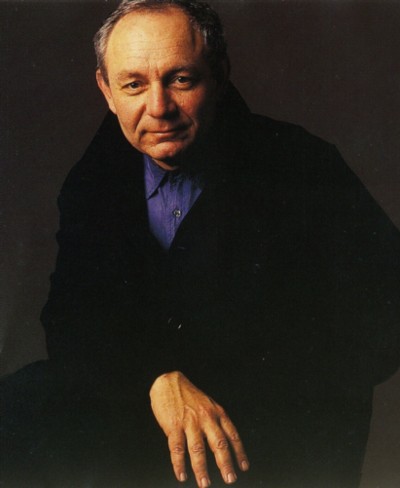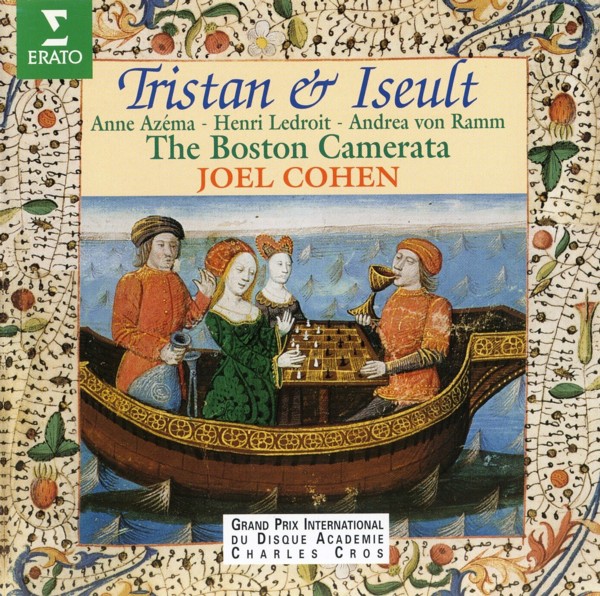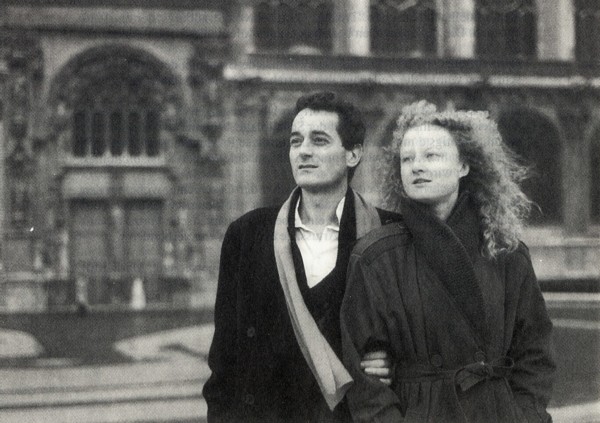
medieval.org
bostoncamerata.com
1987: Erato ECD 75528
1995: Erato 4509 98482-2
2008: Erato 4696340 ‘sans textes’
Vienna: anonyme, Vienna, B.N. ms. 2542
Prologue
1. Vienna, lai 2. Opening Music [2:50]
2. anonyme, attribué à Tristan. Le lai du chevrefeuille [3:12]
Tristan in Dublin
3. Vienna, lai 1. “Lai mortel” [1:54] H. Ledroit · vocalise
4. Jean BODEL, d. 1210. Les un pin verdoyant [1:54] A. Azéma
La traversée d'Irlande en Cornouaille/Le philtre d'amour
5. Gottes namen varen wir [1:27] ensemble
6. Vienna, lai 16, “Le lai du boire”. La u jou fui dedans la mer [5:33] H. Ledroit
7. Contessa de DIA, 12th c. | melody: Vienna, lai 3. Estat ai en greu cossirer [3:34] A. Azéma
Brangane
8. GOTTFRIED | melody: “Gottes namen fahren wir”. Dô wir zwô vuoren [2:34] E. Hargis
9. anonyme, Carmina Burana, 12th c. Bache bene venies [2:49] R. Morrison, ensemble | CB 200
Un Rendez-vous nocturne
10. Guiraut de BORNEILH, d. ca.1215. Reis Glorios [3:48] E. Hargis, H. Ledroit
Les amants surpris
11. Vienna, lai 3. Interlude [0:49]
12. Conon de BÉTHUNE, c. 1150-1220. Se rage et derverie (strophes 1-3) [2:08] R. Morrison
L'épreuve d'Iseult
13. Guiraut RIQUIER, ca.1230-ca.1300. Jesu Crist [1:55] A. Azéma
14. [6:08]
anonyme, 13th c. Pange melos lacrimosum — W. Hite, R. Morrison
anonyme, 13th c. D'une fausse ypocrisie ~ Lux magna — E. Hargis
anonyme, 12th c. Alleluia, salva nos, Christe salvator — A. Azéma, W. Hite, R. Morrison
anonyme, 13th c. Alle, psallite, cum luya — A. Azéma, E. Hargis, H. Ledroit, ensemble
L'exil
15. anonyme, 13th c. Gaite de la Tor [2:40] W. Hite
16. Conon de BÉTHUNE. Se rage et derverie, strophe 5. Mout est le tere dure [1:27] R. Morrison
Tristan et Blanchemains
17. Vienna, lai 13. Lonc tans a que [1:51] H. Ledroit
18. Thomas de BRETAGNE | melody: Alfonso el Sabio, 13th c., “Des oge mais”. Ysolt, bele amie [3:28] A. von Ramm | CSM 1
19. Vienna, lai 14. A vous, Tristan, amis verai [2:51] A. Azéma
20. Marie de FRANCE | melody: Vienna, lai 8, Le lai du chevrefeuille. Assez me plest e bien le voil [4:45] E. Hargis
La mort de Tristan
21. Thomas de BRETAGNE | melody: Vienna, lai 16. Senz aïe m'estut murir [2:56] H. Ledroit
22. Vienna, lai 1, “Lai mortel”. Ja fis canchonnetes et lais [3:42] H. Ledroit
La mort d'Iseult
23. Vienna, lai 2. Li solaus Lluist [3:32] A. Azéma
24. Thomas de BRETAGNE | melody: Vienna, lai 8. Epilogue [0:58] A. von Ramm

THE BOSTON CAMERATA
Joel Cohen
Henri LEDROIT (haute-contre) — Tristan
Anne AZÉMA (soprano) — Iseult
Ellen HARGIS (soprano) — Brangane
Richard MORRISON (baryton) — Mark / marin / moine
William HITE (tenor) — gardien / marin / moine
Joël Cohen, luths, percussion
Cheryl Ann Fulton, harpe médiévale
David Douglass, rebec, vielle
Carol Lewis, rebec, vielle
Jesse Lepkoff, flûte traversière, flûte à bec
Et
Steven Lundahl, trompette à coulisse et flûte à bec
Dan Stillman, bombarde
Andrea von RAMM — narration

Enregistrement numérique
Enregistrement réalisé en Septembre 1987
Church of the Covenant, Boston, Massachusetts, USA
Direction artistique de l'enregistrement: Joël Cohen
Ingénieur du son: David Griesinger
Coordination artistique: Kati Mitchell
Montage: Everett Porter (Sound mirror)
Remerciements/Thanks to Cheryl Fulton and David Douglass
For helping to conceive and prepare the instrumental realizations
Conseiller pour les textes en Ancien Français: Howard Garey
Conseiller pour les textes en Ancien Allemand: Andrea von Ramm
Remerciements/thanks to: the Yale University Language Laboratory
Traduction française: John Underwood
Musical editions, texts, english translations and annotations
© 1987, 1988 Joël Cohen
Deutsche Übersetzung: Maria Mill
Nous remercions pour leur soutien financier:
Ministère des Affaires Etrangères de la République Française,
Boston-Strasbourg Sister City Association
cassette: MCE 75528
© Erato-Disques S.A. 1989
Recto : Tristan en prose - Bibliothèque Nationale, Paris - fr 112, f° 239 Cl. B.N.
Verso : Joël Cohen - Photo Herb Snitzer
Erato 4509 98482-2 (1995):
Verso : Joël Cohen - Photo Herb Snitzer


